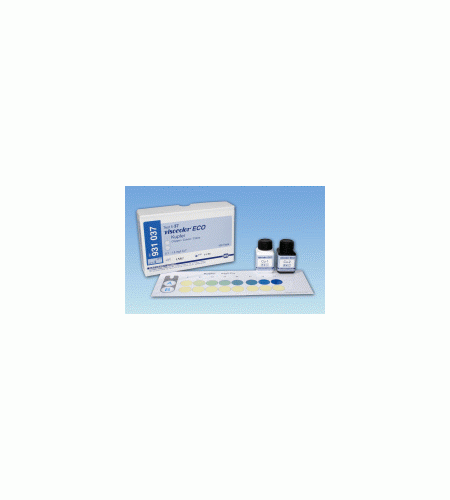COPPER TEST KIT
Copper
Test kit for performing colorimetric tests
on copper ions in surfacewater and sewage
RANGE
0.1 - 1.5 mg/l
RANGE
0.1 - 1.5 mg/l
Method:
Combined with caparison [oxalic acid bis(cyclohexylidene hydrazide)],
copper
(II) ions form a blue complex in the alkaline range.
Measurement range:
0.1–1.5 mg/L Cu
2+
Contents (*refill pack):
sufficient for 100 tests
30 mL Cu-1*
20 mL Cu-2*
2 screw-plug measuring glasses
1 slide comparator
1 color chart
1 plastic syringe 5 mL
1 instruction for use*
Hazard warning:
This test does not contain any harmful substances which must be
specially
labelled as hazardous.
Instructions for use:
also refer to the pictogram on the back of the color chart
1. Pour a
5 mL water sample
into each of the measuring glasses us-
ing the plastic syringe.
Place a measuring glass on position A in the comparator.
Only add the reagent to measuring glass B.
2. Add
5 drops of Cu-1
, seal the glass and mix.
3. Add
5 drops of Cu-2
, seal the glass and mix.
4. Open the glass after
10 min
and place it on position B in the com-
parator.
5. Slide the comparator until the colors match in the inspection hole on
top. Check the measurement reading in the recess on the compara-
tor reed. Mid-values can be estimated.
6. After use, rinse out both measuring glasses thoroughly and seal
them.
The reagents can be used for the
photometric evaluation
with pho-
tometer PF-12 / PF-12
Plus
.
This technique can be used also for analyzing sea water.
Disposing of the samples:
The used analysis specimens can be flushed down the drain with tap
water and channelled
off to the local sewage treatment works.
Interferences:
Strongly acidic and buffered test samples are to be adjusted to pH 9
with ammonia before determination.
Iron(II), chromium(VI), nickel and manganese ions disrupt tests if they
are present in concentrations in excess
of 10 mg/L. Chromium(III) ions
present in concentrations in excess
of 10 mg/L cause clouding and lead
to limited results. Cobalt ions form a red color complex and, depending
on the concentration of copper, disrupt the tests if present
in concen-
trations from as little as 1 mg/L. If cyanide and sulfide are present in
concentrations in excess of 1 mg/L, they will lead to limited results.
Storage:
Store the test kit in a cool (< 25 °C) and dry place.


